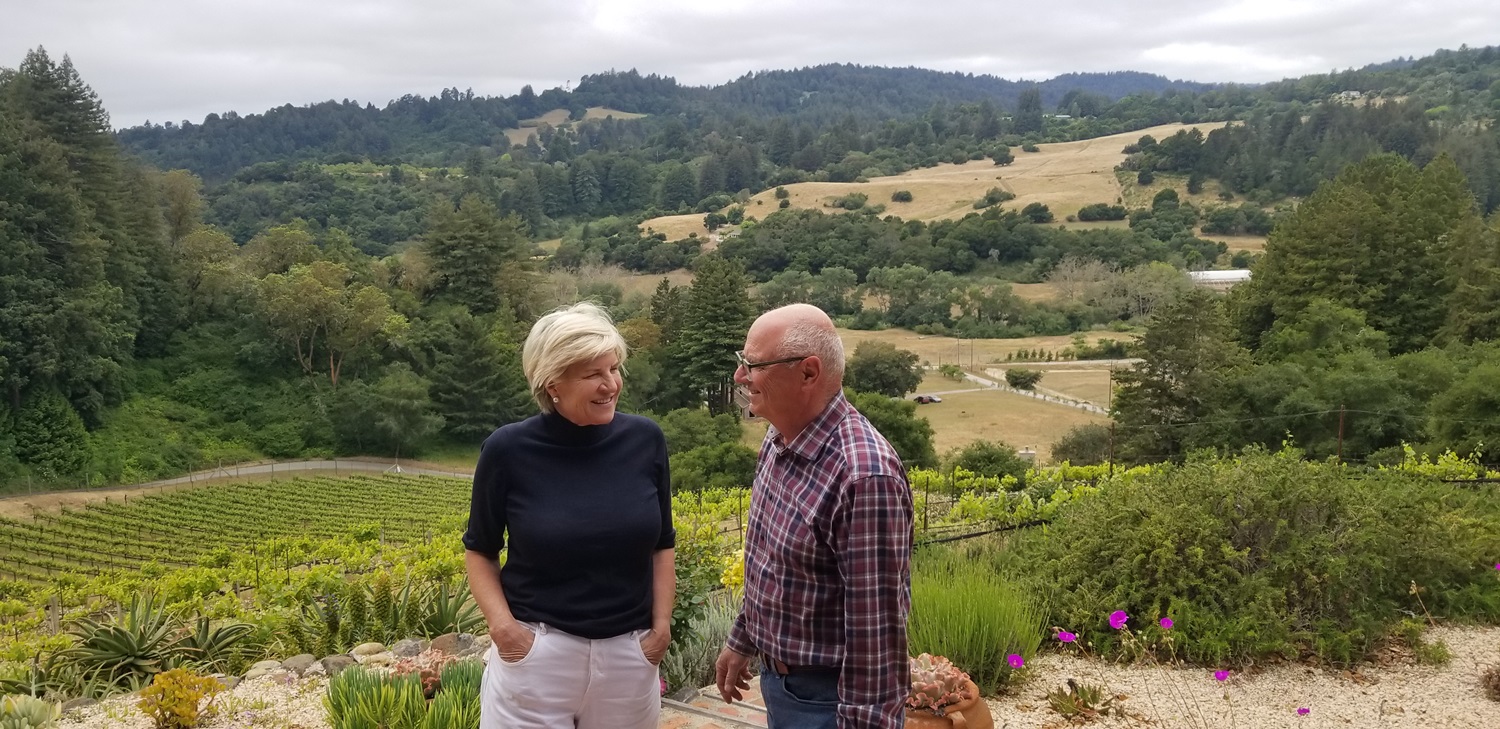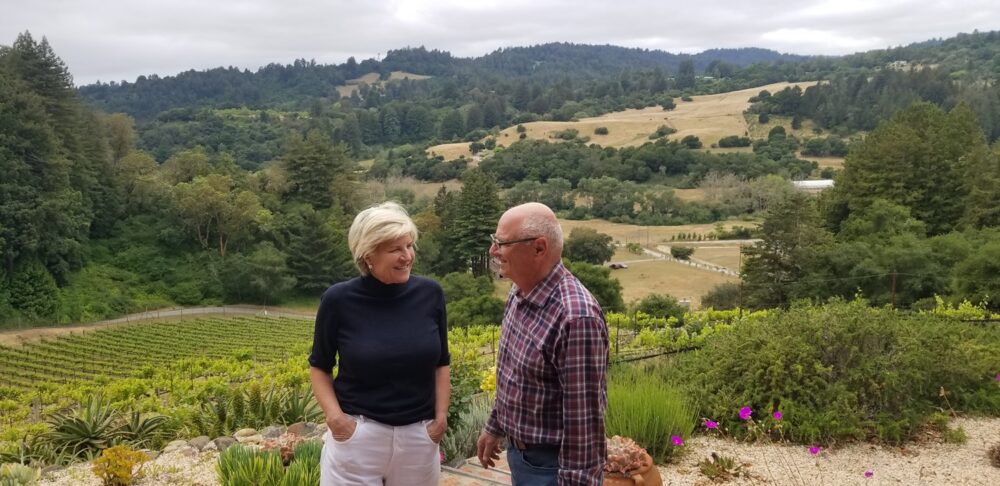
Whenever I’m burned out on the wine scene – the trends, the trappings, the persistent elitism – I head to the Santa Cruz Mountains AVA. Of the over 300,000 acres that comprise the appellation, only 1,700 of them are planted to vines. The rest of the Santa Cruz Mountains AVA is wild, often remote terrain, covered in dense groves of redwoods, madrones, and oaks. Roadsides are covered with dewy maidenhair ferns and tall, indigenous grasses. Thick beds of fog move through the region with abandon, often obscuring winding roads and winery entrances.
Faint-of-heart travelers need not visit, as their mettle and sense of direction will be tested. Adventurous road trippers, however, on the hunt for energetic, bracing mountain wines will be generously rewarded by this rare, visually arresting place. It’s the ideal region to visit when you want to fall in love with wine all over again, because it takes engagement, stamina, and focus to visit it properly. The rewards of doing so are numerous.
It’s a decentralized region, so no matter where you stay, you’re going to have to put some miles on your car. This time around, I’m staying at the Capitola Hotel, a small, clean seaside hotel in the little village of Capitola. It’s conveniently located along restaurant row and directly across the street from the Pacific Ocean. I start each morning with a warm Chai Latte from Mr. Toots Coffeehouse across the way and enjoy it while walking along the shoreline, watching surfers post up for the day.
Day 1: Ferrari Ranch, Big Basin Tasting Room & Wine Bar
I wind my way from Capitola to the nearby Corralitos sub-appellation. The appellation’s small town goes by the same moniker and is best known for its small vineyards, strawberry fields, apple orchards, and the Corralitos Market and Sausage Co., a great butcher shop and deli. Corralitos is at the southern edge of the Santa Cruz Mountains AVA and is home of the Forest of Nisene Marks, a lush, verdant state park offering over 40 miles of hiking trails. My first winery stop in Corralitos is Ferrari Ranch.
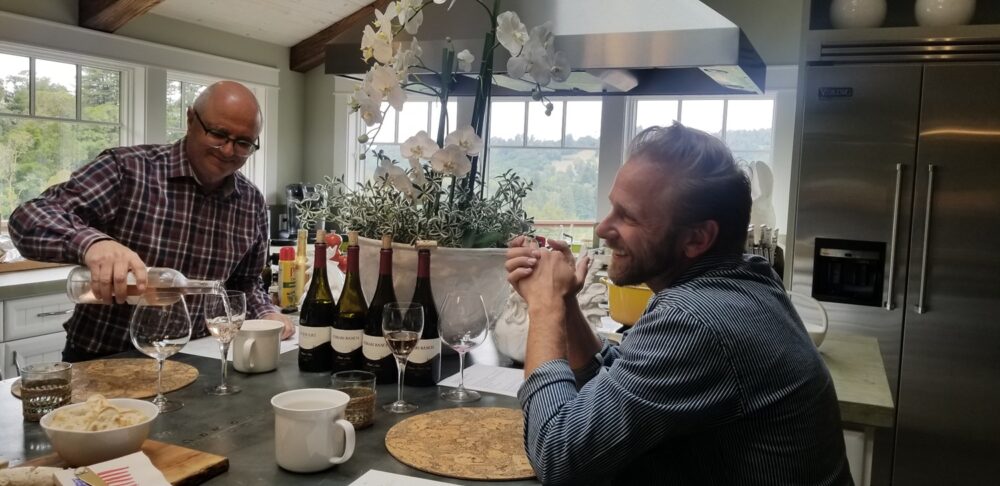
Dave Ferrari and winemaker Ross Reedy at Ferrari Ranch
Dave and Liz Ferrari released their first Pinot Noirs and Chardonnays from their Ferrari Ranch estate vineyard in 2018. Dave, the grandson of Sicilian farmers who settled in Santa Clara Valley at the turn of the century, is a serious, methodical farmer, and it shows in their balanced, fresh wines. The estate is farmed using regenerative farming practices, and there’s a vibrancy and energy at their hilltop location that seems to reflect a vineyard in harmony with its natural setting. “There’s something very cleansing about being outside, working the soil, getting dirt under your fingernails. Soil is the essence of life,” Dave tells me as we taste. The hillside Ferrari Ranch vineyard is at about 700 feet elevation and the wines benefit from a prevalent fog at the estate and a diverse stratum of soils. The Ferrari Ranch team is impressive and includes winemaker Ross Reedy (also with Truett Hurst) and legendary grape farmer Prudy Foxx. If you do a deep dive into the Santa Cruz Mountains, you’ll hear Foxx’s name repeatedly. The locals call her the Grape Whisperer. “If you’ve got the right people, you can do amazing things,” Dave tells me. The patio off their tasting area offers sweeping views of the Corralitos countryside below, with horse farms and fruit orchards dotting the landscape. Tastings are hosted by Dave and Liz Ferrari and are $20 per person.
From there, I make my way to downtown Santa Cruz. Surfers, hippies, hipsters, and the homeless all lay claim to this beach town. Big Basin Vineyards has opened a tasting room and wine bar downtown that I’m eager to try. When I arrive, owner Bradley Brown greets me at the door. He’s busy building a home nearby on the beach, as his former residence was destroyed in the Santa Cruz fires of 2020. Fit and enthusiastic, he takes me through a flight of his current releases, which we enjoy with a plate of warm, freshly made Pancho’s Empanadas, one with beef and the other with spinach and ricotta. Brown pours me his Riesling from Wirz Vineyard in the Cienega Valley and a Santa Cruz Mountain-grown Pinot Noir from closer to home. Both wines are brisk, fresh, and balanced.
Over the years, Brown’s craftmanship as a winemaker has evolved, from bigger, fleshier wines to wines of delineated aromatics, higher acid, and a more precise texture. Across the board, they’re vibrant and pretty and are well-paired to the foods Brown has chosen for Big Basin’s menu, which also includes the arancini, boquerones, and trout salad we enjoy while he tells me about his new, soon-to-be neighborhood.
Though he lost his home and much of his estate vineyard in the 2020 fires, he’s surprisingly buoyant, showing me renderings of his future beachside home and pointing out aspects of his urban neighborhood, which includes a nearby, newish apartment building just steps away from where we are seated, and from which young professionals descend during after-work hours to grab a glass and a bite to eat. Food items are reasonably priced and tasting flights range from $15 to $28 per person.
Day 2: Rhys Vineyards, Mindego Ridge, Sander Hem, Santa Cruz Mountain Vineyard
It’s a blustery morning when I pull up to Rhys Vineyards. I meet with winemaker Jeff Brinkman, who’s been on board since the brand’s inception in 2001. Avuncular, well-spoken, and thoughtful, Brinkman pours me all their 2021s. Brinkman’s gift, in addition to shepherding in modern classics that are unusually balanced and refreshing, is breaking down the appellation’s singularity in ways that are easy to comprehend.

Winemaker Jeff Brinkman of Rhys Vineyards
“What drives the entire Rhys project is that the San Andres Fault is in the bottom of the valley. People understand what the fault is, but what not everyone truly understands is that it’s a meeting place between two major tectonic plates, the North American plate here and the Pacific plate to the west. The Pacific plate is an old sea floor bed, so when these two met and formed the mountains, the Pacific plate got turned up 90 degrees like a geologic layer cake. That exposed all the geology laterally and that’s sea floor bed, which is what we want: limestones and shales. On the Pacific plate, you can walk a very short distance and cross a big amount of geologic age. We have two vineyards about 5 miles west of here, Alpine and Horseshoe, and they sit 400 meters apart, but there’s 12 million [years of] geologic age between them.”
The genesis of the Rhys project was to find sites that are all on distinct geology. Of the six Santa Cruz Mountain vineyards farmed by Rhys – Family Ranch, Alpine Road Vineyard, Skyline Vineyard, Home Vineyard, and Horseshoe Ranch Vineyard – there is no repetition in geology. Serious wine drinkers, especially those enchanted by the notion of terroir, will be well served seeking out these rare mountain gems. Tastings offered upon availability to mailing list members only.
After leaving Rhys, I wind my way up to Mindego Ridge, a 10-acre estate about 8 miles from the Pacific, planted mostly to Pinot Noir and just over an acre of Chardonnay. I’m greeted by owners David and Stacey Gollnick and almost immediately hop onto a trolley of sorts that David guides through the estate’s steep trails. The air is redolent with conifer and wet earth as we make our way to vineyard rows buttressed by dark, rich forest. The immersive tour is highly recommended, delivering one straight into the heart of this mountainous terroir.
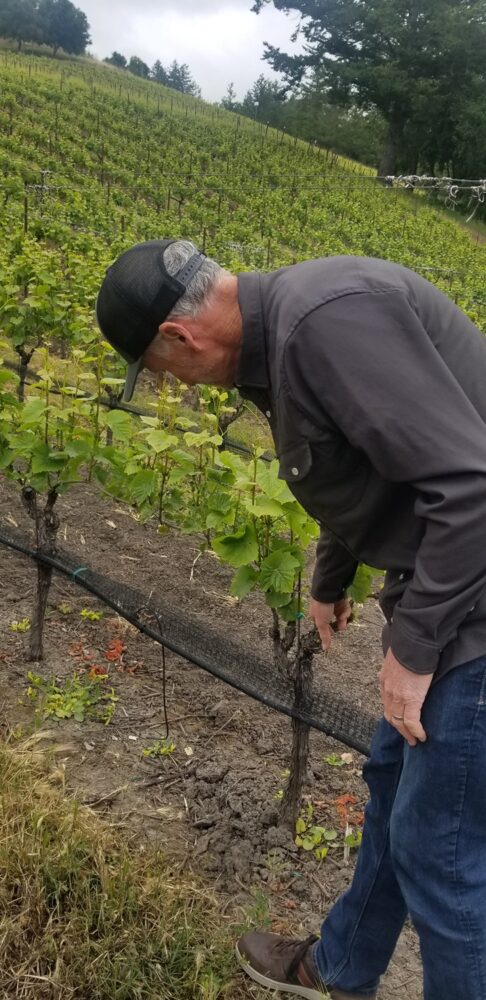
David Golnick of Mindego Ridge
The estate Pinots from this site are wound tight, demanding cellaring or decanting. I gravitate instead to their pretty, lifted estate Chardonnay, a wine with length and wonderful texture. At under 50 bucks a bottle, it over-performs. Tastings at Mindego Ridge range from $30 to $40 a person.
About halfway through our visit, we’re joined by Robert Bergstrom, owner and winemaker of Sandar & Hem, a project I hadn’t heard of until now. Founded in 2018, the name pays tribute to Bergstrom’s Norwegian roots; his ancestors, the Hems, were from Sandar, now the Sandefjord Municipality. Bergstrom, who has a Ph.D. in Biophysics, makes astoundingly precise and pretty wines under Sandar & Hem. The 2021 Sandar & Hem Chardonnay is a highlight from this trip, as is his 2021 Mindego Ridge Deerheart Vineyard Pinot Noir. Having worked under Jefferey Patterson at Mount Eden, Bergstrom seems to have a keen understanding of typicity, restraint, and length in a wine.
As the day winds to a close, I make my way to Swift Street Courtyard, an old Brussels sprout packing plant that’s been converted into a collection of shops, tastings rooms, and the popular natural wine bar Apero. Just across from Apero is Santa Cruz Mountain Vineyard, helmed by winemaker and owner Jeff Emery. Emery has Santa Cruz in his soul, having started winemaking at SCM while in his twenties and still attending UC Santa Cruz. He later took over ownership from the winery’s founder and his mentor Ken Burnap. Emery’s winery isn’t anything fancy. It’s disorganized and disheveled. Travelers looking for fancy digs will want to move along, but if you’re on the lookout for wines with tremendous heart, you’ll want to take a seat at one of the barstools and settle in for a while.
Emery doesn’t appear to adhere to trends or the whims of the market or critics. He’s producing a lineup of Portuguese varietal wines under his label Quinta Cruz that includes Souzao from a couple of different sites, a Palhete, and an Arinto. He’s also got a great stand-alone Alicante Bouschet, a terrific Durif, cool climate Grenaches and Syrahs, Cabernet Sauvignon, Pinot Noir, Chenin Blanc, and a few others. His signature is length; all the wines have great structure and he’s got a great library of wine, which we dip into, proving his wines hold on to their life and vitality for over a decade. One of the standouts from our tasting is a 2012 Santa Cruz Mountains Pinot Noir, the Vine Hill Reserve, which is incredibly lively and spirited. It’s just now starting to show itself. Emery is considered a pioneer and legend around these parts, and he’s mentored a few talented winemakers, including Cole Thomas of Madson Wines, whom I’ll have lunch with the next day. Tastings at Santa Cruz Mountain Vineyard are $20 per person.
Day 3: Beauregard Vineyards, Madson Vineyards, Alfaro and Farm Cottage Wines
Winemaker Ryan Beauregard, looking every bit the farmer and mountain man, greets me warmly and welcomes me into their historic tasting room, which used to be The Lost Weekend, an old watering hole in Bonny Doon that served its last drink about 40 years ago. The redwood cabin walls are lined with photos of the Beauregard family, including one of Ryan on a tractor when he was just a boy.
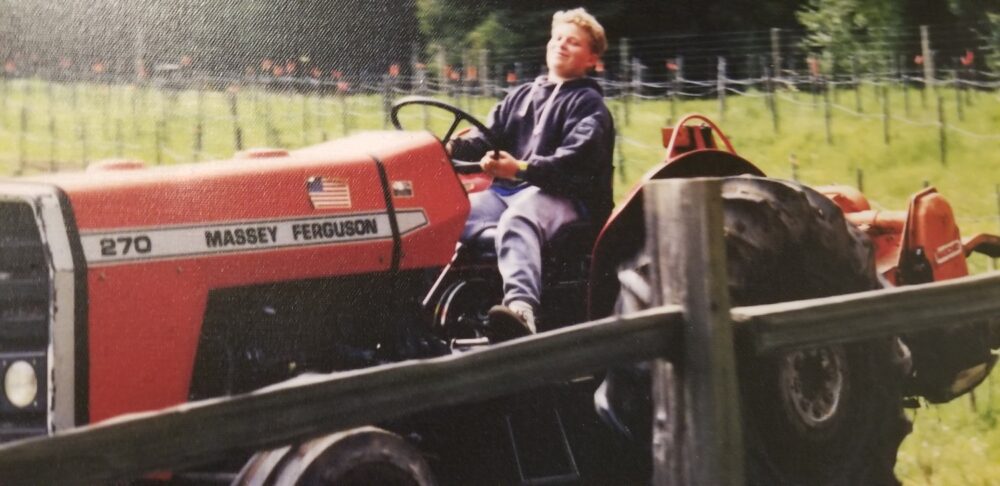
Young Ryan Beauregard
Though their first commercial vintage was in 2000, the estate vineyard has seen about 153 years of production, having been replanted a few times. Ryan Beauregard was born right next to a block of Chardonnay, and his affinity for their estate fruit shows in their incredibly zippy and bright Bald Mountain Chardonnay, my favorite wine in their lineup, which also includes some beautiful Zinfandels.
The estate vineyards are all sandy soils, which Beauregard believes accounts for the hallmark minerality that courses through their wines, particularly the Chardonnays and Pinots. Their lineup is a study in structure and age-worthiness. Beauregard pours me some older vintages, and they’re just now unwinding, just now beginning to uncoil towards beauty.
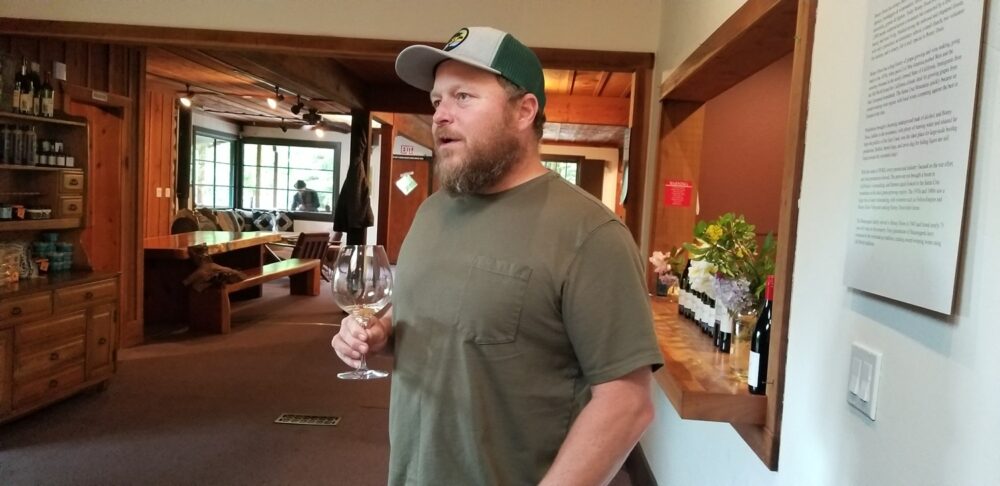
Ryan Beauregard today in Beauregard’s historic tasting room
There’s a strange phenomenon in American wine culture. If a brand has been around for a while…say, 20, 30, 40, or 50 years, the media grows tired of them and wants to write about the next big thing or the newest cool kid on the block. And yet those same writers fawn all over Old World properties that have been around for hundreds of years and anoint them with the kind of gravitas rarely shown to domestic brands. Older brands like Beauregard, which is only 23 years old, deserve some attention for their staying power and consistency. Tastings are $25 per person.
Madson Wines, also in the Swift Street Courtyard, will become my favorite discovery from this trip. Winemaker Cole Thomas leads me into Madson, an urban winery and tasting room with a mid-century modern sensibility. I follow him as we walk the length of their tidy, small production space, all the way to a makeshift kitchen where assistant winemaker Tino Paccione is shucking fresh raw oysters for our lunch.
We sit at a wooden table where Thomas pours the 2022 Ascona Vineyard Chardonnay. Taut, bursting with vitality, and well-balanced, this serious effort suggests a wine house that is here to stay. Though Madson has been around since 2016, when they made only 25 cases of wine, they’re just now coming into their own, having assumed this winery space just over a year ago.
Thomas’ signature as a winemaker seems to be transparency and life. The wines are poised to age well, and while they take a while to unwind, when they finally do, they deliver restrained pleasure, profound beauty, great structure, and a lively, eager texture.
Thomas, earnest and well-spoken, began his career at Santa Cruz Mountain Vineyard while still attending UCSC, where he managed the Demeter Seed Library, a non-profit comprised of local farmers and gardeners committed to preserving the genetic heritage of our food. The Madson lineup of wines reflects his respect for the natural world. Readers who are typically dismissive of natural wines for their lack of soundness ought to give these wines a try. They’re what natural wines promise to be: vigorous, brisk, buoyant.
There isn’t a wine in the lineup I wouldn’t recommend, but the 2022 Ascona Pinot Noir and the 2022 Branciforte Pinot Noir are standouts, with the kind of lifted, pretty aromatics that I find rare in modern Pinots. I’m a sucker for cool climate Syrahs, and Madson’s 2022 Syrah from the Kessler-Hawk Vineyard in the Sta. Rita Hills is stunning. Not since I discovered Arnot Roberts and their Clary Ranch Syrah years ago have I been this moved by a cool climate Syrah from California. It’s nimble and animated, with an unstoppable aromatic lift of violet pastilles and salty ocean breezes, wet earth and chanterelle. The Madson wines are urbane, so I’m not surprised to hear they’re carried by Martine Wines in New York, a splendid, legendary book. In their youth, Madson wines can seem astringent without proper decanting. I recently opened their 2022 Toyon Vineyard Pinot Noir and decanted it for 36 hours, at which time it opened beautifully with no noticeable astringency.
Thomas is shy and soft-spoken, but as he directs his attention to speaking about the wines, he gradually comes out of his shell. “Madson was my grandmother’s maiden name. She was the first to come to the US from Denmark by boat. She is a badass, matriarchal figure on my dad’s side. It was an easy choice.” For die-hard mountain fruit wine lovers, a trip to Santa Cruz Mountains isn’t complete without a visit to this producer. Tastings are $25 per person.
At day’s end, I head over to Alfaro Family Vineyards in Corralitos. I’ll be joining the Alfaro family for dinner in their home, but first I stop by their tasting room and go through their current lineup with Ryan Alfaro, who has assumed the role of winemaker at Alfaro Family Vineyards, and his own brand, Farm Cottage Wines. His dad Richard, who made site-specific, balanced wines from their Corralitos estate for years, now devotes his time to managing and farming the estate vineyard. “I think my dad is the best farmer around,” Ryan says.
Looking like a young Matthew McConaughey, Ryan steps behind the tasting room bar and begins popping corks. He’s a confident, talented winemaker, having worked under the inimitable Adam Tolmach at Ojai Vineyard before assuming the reins here. Ryan was born in Santa Cruz and possesses the kind of easy, breezy surfer vibe that is at once casual and unassuming while remaining deeply engaged and present. The wines he makes for Alfaro and Farm Cottage are made to age, with high levels of natural acidity, well-managed tannins, and a mouthwatering texture.
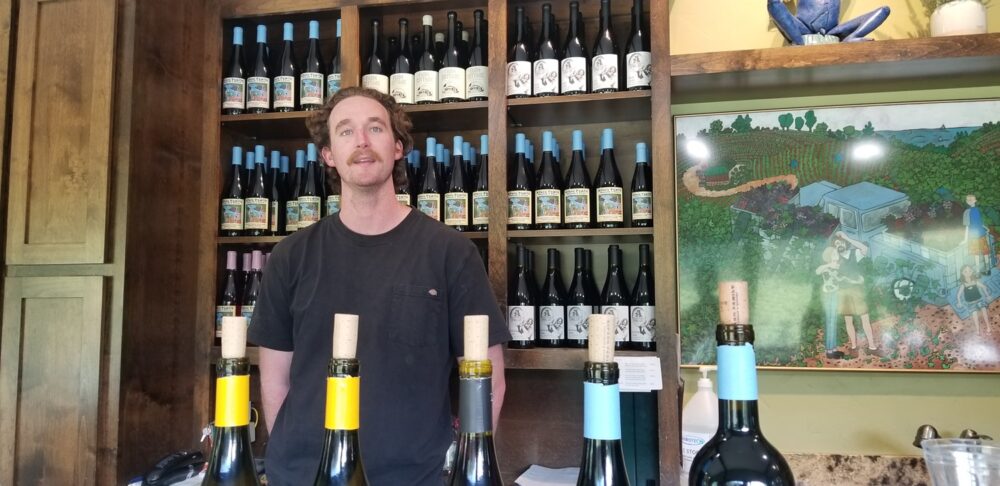
Winemaker Ryan Alfaro
The Alfaro family has been farming in Santa Cruz since the late 1990s, when they acquired an aging apple farm that they later planted over to their estate vineyard.
The first thing that catches my eye when I drive up to the Alfaro residence is a huge Pickleball flag flying over their pickleball court, as both Richard and Mary Kay are obsessed with the sport and often play in tournaments. Richard is making dinner when I arrive. Mary Kay has recently stepped away from managing the tasting room, though she remains the administrator of their wine club. “They ask for her all the time,” Richard says. The couple has been together for 40 years, having met while students at U.C. Santa Barbara.
We kick off the evening with their 2014 Pinot Noir, which is still incredibly young, lovely, and sound and sets the stage for the rest of the evening’s wines. It’s the perfect way to end my last full day of tasting in the Santa Cruz Mountains appellation. Alfaro’s wines are popular on restaurant lists and for good reason. The high degree of natural acidity across all the wines is the perfect accompaniment to food, and the tension evident in mountain fruit ensures the wines remain lively in the glass, even after hours of good conversation.
Day 4: Lester Estate Vineyards
Before I head out of town the next morning, I swing by Lester Estate Wines, also in Corralitos, known for its unique approach to collaborative winemaking. Lester Estate Wines has five (!) winemakers from around California, each interpreting the estate fruit in their own way: John Benedetti (Sante Arcangeli Family Wines), Emiddio Justin Massa (Mansfield-Dunne), Dan Person (Carboniste), Ryan Reedy (Truett-Hurst), and Ian Brand (I. Brand). It’s exciting and fun to try wines from the same vintages and estate, interpreted by different winemakers, especially side by side. The wines are all high-quality and well-made, and it will be up to the taster to decide which they like best. Some of the winemakers seem to use oak for textural purposes only, while others use oak for its flavor-bearing compounds. Either way, there’s literally something for everyone at Lester, and the tasting room is trippy and wonderfully weird. Owner Dan Lester, who was part of the archeological team that recovered the lost ship Nuestra Señora de Atocha, is an adventurer, and so the tasting room is filled with antiquities and ephemera from around the world that he picked up on his travels. The visual experience of this tasting is worth the trip alone, and the wines sealed the deal for me. Tastings are available on Saturdays only and are $20 per person.
